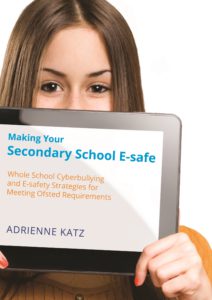 Research shows that for many schools it is hard to keep up with the high speed train that is a student’s online life. New apps and high risk behaviours emerge at the same time that new Ofsted inspection requirements are outlined. Only 45% of secondary pupils strongly agree that their teachers know enough about online safety, whilst Ofsted says that training for teachers is inconsistent[1]. So how do you address the fastest evolving aspect of a young person’s education today?
Research shows that for many schools it is hard to keep up with the high speed train that is a student’s online life. New apps and high risk behaviours emerge at the same time that new Ofsted inspection requirements are outlined. Only 45% of secondary pupils strongly agree that their teachers know enough about online safety, whilst Ofsted says that training for teachers is inconsistent[1]. So how do you address the fastest evolving aspect of a young person’s education today?
Firstly, there’s a new name for e-safety – it is now known as Online Safety since the new framework for inspection in September 2015.
Secondly, when did you last update your Acceptable Use of IT policy and have your staff and students signed it? In 2015, Ofsted found that fewer than half of secondary school students had signed an AUP and more than 3/4 of secondary students had not been involved in writing their school’s e-safety policy.
Thirdly, staff training should be ongoing – only 59% of primary school staff have received training in the previous 12 months (Ofsted).
Fourthly, make your online safety education programme age appropriate, nuanced and meaningful to students. Involve them as partners in an ongoing dialogue, not a single session facilitated by a guest or an assembly. It should be embedded in the curriculum, a living breathing part of school life today. Students told me when I was researching my latest book, Making Your Secondary School E-safe, that they never wanted another e-safety assembly again but instead needed practical workshops and discussions about situations that could arise, problem solving tools and ways to get help. They are bored with e-safety and the age at which they are least likely to follow the advice is 14-15 – the very age at which cyberbullying and other high risk online behaviours peak.
Fifthly, prepare children ahead. Look at the average age at which primary pupils are given mobile phones or tablets in your area. If the average age is 11 they should be well prepared for what they will meet. Teach them e-safety basics and how to recognise in–app purchases, gamers who are strangers, games’ age ratings, or chainletters containing threats. Work hard on your equality and anti-bullying ethos within school as it is now that they begin to receive online abuse that is racist and often homophobic.
Use your teaching skill to keep lessons divided into short segments, re-cap often and use games, digi-dilemmas and quiz or word-search items to keep their interest. Allow students to ask questions in confidence afterwards or in a follow up opportunity. Link up Online Safety with PSHE, SRE, Inclusion, Equality, Behaviour and Safeguarding, plus Child Protection. Finally, see the full picture, so that you can readily slot e-safety into other current initiatives like those on mental health and wellbeing.
Adrienne Katz is the author of Making Your Primary School e-Safe and Making Your Secondary School e-Safe. She delivers CPD accredited training. www.esafetyforschools.com
[1] Ofsted 2015, Online Safety Survey